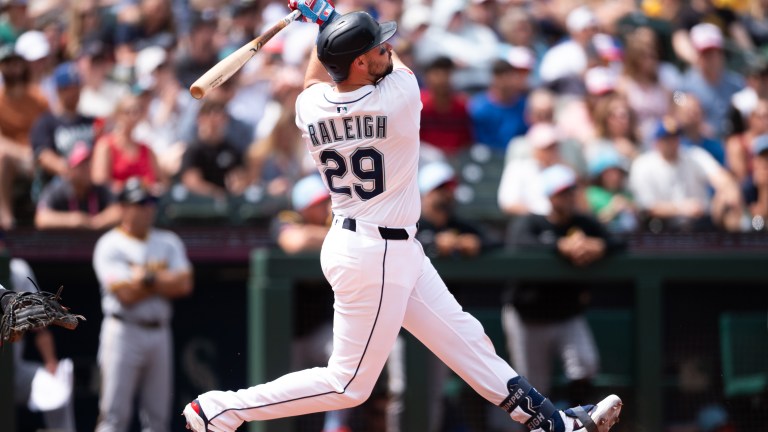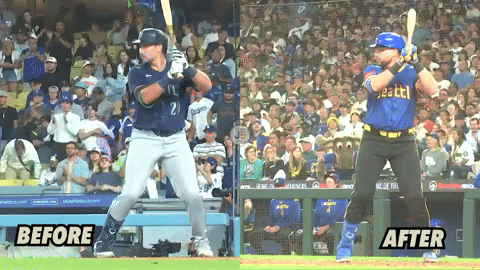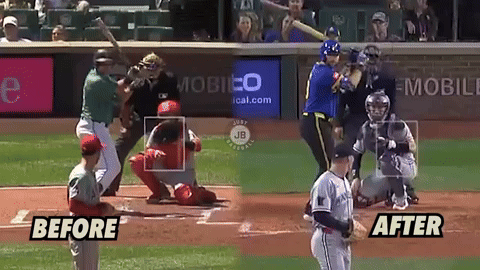What Changed to Unlock the Best Version of Cal Raleigh?
Key swing changes have transformed Cal Raleigh into an MVP candidate in 2025, as he turned his biggest weakness into a strength.

Heading into this season, Cal Raleigh was already a proven commodity at the catching position. When you pair his defensive prowess with roughly a mid-700s OPS, he was not only a great catcher, but arguably baseball’s best.
An OPS north of 1.000 with 32 homers through his first 83 games has shifted the conversation from whether Raleigh is the best catcher in baseball to whether he can put up the best season in the history of the position.
That kind of offensive leap almost has to come with some sort of mechanical adjustment, which sent me down the rabbit hole to explore what is different this year.
Sure enough, there’s a clear shift in Raleigh’s operation in the box that has turned something that was somewhat of a weakness before into a massive strength.
In 2023 and 2024 combined, Raleigh slashed .201/.302/.399 against fastballs 93 MPH and above. From the right side of the plate, Raleigh was even more challenged by velocity in that span, hitting just .123/.188/.274.
Raleigh was able to maintain a .755 OPS in those two seasons based on his ability to punish bad fastballs and spin. His OPS of .810 against breaking balls was well above the league average, and the roughly 7% of the time he saw fastballs below 93 MPH, he crushed them to a .950 OPS.
The Swing Changes
If a hitter is struggling to catch up to velocity, conventional thinking would be to start the load earlier, but that is easier said than done.
Raleigh utilizes a decent-sized leg kick, which means if he starts it earlier, he will need to have good lower-half balance and generally find a way to stay back, especially on off-speed stuff.
That said, he has a track record of crushing secondaries with velocity being the Achilles heel, so it makes sense to try to figure out how he can start his operation sooner.
Starting with the basic setup changes, Raleigh is more upright with his hands higher and the barrel flatter. Being more upright gives Raleigh more room to operate as he starts his load earlier. Being more crouched previously made it more difficult to have a counter-move, which is generally necessary when trying to start the load earlier.

Now, instead of just picking his foot up and having nowhere to go but forward, he can buy himself more time by sinking and coiling into his backside as he strides. This gives him the equalizer to keep his weight back as he starts his load earlier.
In the open-side video above, Raleigh’s flatter barrel is more evident in both his setup and as he gets slotted. While it is not a one-size-fits-all change, it’s not uncommon for a hitter to have an easier time getting on plane with a less vertical bat angle through the setup and load.
You can see the rhythm he now possesses in his load from the open side as well, but it’s really clear how much earlier he is starting things from the centerfield angle below.

If you compare where his front leg is at when the pitcher is releasing the ball, Raleigh is already bringing his foot back down in his new swing, while he is still reaching the peak of his leg kick in the old swing. This allows him to dictate his own rhythm and pace rather than feeling rushed to get planted.
A pitcher’s job is to disrupt a hitter’s timing and with Raleigh’s earlier, slower and more controlled load, he is able to dictate his own timing more easily, but most importantly, he’s in position to get his A swing off more consistently against velocity, catching the ball further out front.
| Year | Slash Line | Air Pull% | HR Total (Pitches) |
|---|---|---|---|
| vs. FB 93+ MPH (2024) | .193/.298/.369 | 24.8% | 9 HR (758) |
| vs. FB 93+ MPH (2025) | .270/.354/.687 | 32.5% | 14 HR (490) |
The shift is even more staggering from the right-side, where Raleigh’s fastball challenges were exacerbated. In 2023 and 2024 combined, Raleigh hit just .158/.233/.350 against fastballs of all velocities with just seven home runs. The OPS drops to .461 on pitches 93+ MPH in that span.
The 28-year-old has already eclipsed that home run total with eight in a quarter of the time from the right side in 2025, on his way to a .386/.426/1.026 slash line. The changes Raleigh has made were applied to both sides of the plate, but much like his shift in production, the improvements are more drastic from the right side.
His hands were quite loud previously, waving the barrel before and leading into his load, adding an unnecessary variable to his swing timing. When comparing the hand loads, it’s easy to see how the previous move could make him tardy or feel rushed.

Feeling like you’ve got more time in the box can help a hitter a good deal against secondaries as well, as can a path that is in the zone for longer. Raleigh’s OPS against non-fastballs is up nearly 200 points while his ground ball rate is down by six percent and chase rate by four percent.
The Greatest Catcher Season Ever?
It already is an all-time campaign for a backstop. There have only been six primary catchers in MLB history to hit 40 home runs in a season, two of them since 2000 in Javy Lopez (2003) and Salvador Perez (2021).
With respect to both of the slugging backstops, they were not nearly the defenders that Raleigh is in those seasons, and Raleigh may eclipse their home run totals with plenty of time to spare.
Despite seeing his fWAR increase in each of his last four seasons, Raleigh has already posted a career-high in that regard at 5.7 as of July 7th. According to Fangraphs, the highest fWAR season of all time by a backstop was Buster Posey in 2012, which Raleigh is nearly on an exact pace for.
Posey won the MVP that season, so it is no surprise that Raleigh finds himself in that discussion right now, although Aaron Judge is going to be very tough to knock off.
It feels weird to call Raleigh’s season a breakout, as he was already one of the game’s best catchers heading into the season, but what else do you call it when an extremely talented player puts it all together?
If you go to his Savant page, most of the batted ball data is not dramatically different in terms of his percentiles. He has always been able to hit the ball hard and in the air; he just does it as well as anyone in Major League Baseball now.

